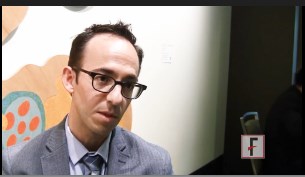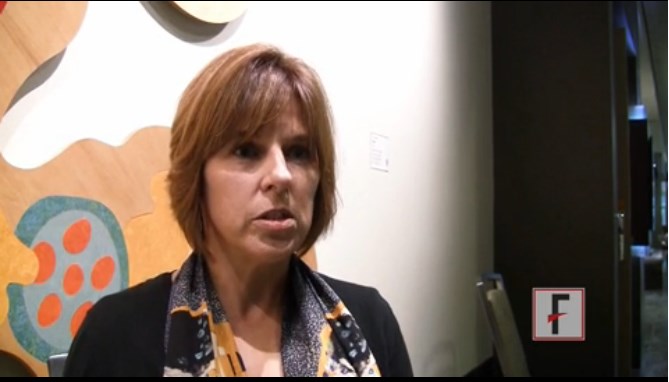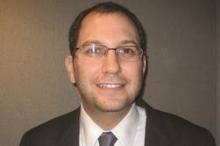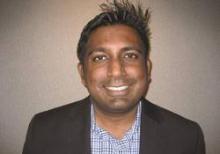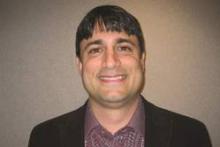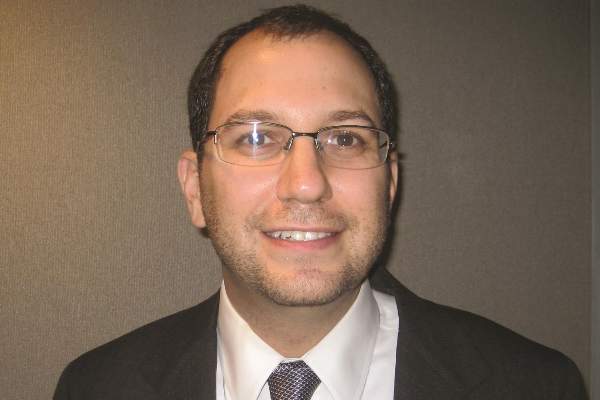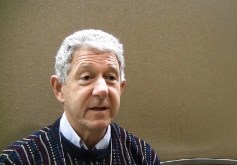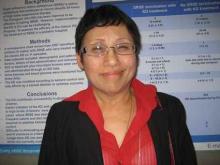User login
American Epilepsy Society (AES): Annual Meeting
VIDEO: Hype outstrips evidence on marijuana extracts for childhood epilepsy
SEATTLE – Desperate for help, many parents have tried treating infantile spasms and other childhood epilepsies with cannabidiol oils.
The Internet is full of parents’ testimonials that the marijuana extracts help. Although parents might be on to something, that won’t be known for certain until results are in from randomized, controlled trials about to get underway.
In the meantime, researchers at the University of California, Los Angeles, took a measure of the excitement in a recent anonymous survey of 117 parents.
In a video interview at the annual meeting of the American Epilepsy Society, Dr. Shaun Hussain, director of the infantile spasms program at UCLA and the study’s senior investigator, explained the survey findings and how to counsel parents pending randomized trial results.
The video associated with this article is no longer available on this site. Please view all of our videos on the MDedge YouTube channel
SEATTLE – Desperate for help, many parents have tried treating infantile spasms and other childhood epilepsies with cannabidiol oils.
The Internet is full of parents’ testimonials that the marijuana extracts help. Although parents might be on to something, that won’t be known for certain until results are in from randomized, controlled trials about to get underway.
In the meantime, researchers at the University of California, Los Angeles, took a measure of the excitement in a recent anonymous survey of 117 parents.
In a video interview at the annual meeting of the American Epilepsy Society, Dr. Shaun Hussain, director of the infantile spasms program at UCLA and the study’s senior investigator, explained the survey findings and how to counsel parents pending randomized trial results.
The video associated with this article is no longer available on this site. Please view all of our videos on the MDedge YouTube channel
SEATTLE – Desperate for help, many parents have tried treating infantile spasms and other childhood epilepsies with cannabidiol oils.
The Internet is full of parents’ testimonials that the marijuana extracts help. Although parents might be on to something, that won’t be known for certain until results are in from randomized, controlled trials about to get underway.
In the meantime, researchers at the University of California, Los Angeles, took a measure of the excitement in a recent anonymous survey of 117 parents.
In a video interview at the annual meeting of the American Epilepsy Society, Dr. Shaun Hussain, director of the infantile spasms program at UCLA and the study’s senior investigator, explained the survey findings and how to counsel parents pending randomized trial results.
The video associated with this article is no longer available on this site. Please view all of our videos on the MDedge YouTube channel
AT AES 2014
VIDEO: Psychogenic seizure patients probably okay to drive
SEATTLE – To be safe, neurologists usually tell patients with psychogenic nonepileptic seizures to limit their driving as much as patients with confirmed epilepsy.
That might be an unnecessary restriction on their quality of life, however, according to a study from the Phoenix branch of the Mayo Clinic.
Epileptologist Dr. Kristine Ziemba, who conducted the study while a fellow at the Mayo Clinic, and is now a neurologist in St. Petersburg, Fla., explained why in a video interview at the annual meeting of the American Epilepsy Society.
The video associated with this article is no longer available on this site. Please view all of our videos on the MDedge YouTube channel
SEATTLE – To be safe, neurologists usually tell patients with psychogenic nonepileptic seizures to limit their driving as much as patients with confirmed epilepsy.
That might be an unnecessary restriction on their quality of life, however, according to a study from the Phoenix branch of the Mayo Clinic.
Epileptologist Dr. Kristine Ziemba, who conducted the study while a fellow at the Mayo Clinic, and is now a neurologist in St. Petersburg, Fla., explained why in a video interview at the annual meeting of the American Epilepsy Society.
The video associated with this article is no longer available on this site. Please view all of our videos on the MDedge YouTube channel
SEATTLE – To be safe, neurologists usually tell patients with psychogenic nonepileptic seizures to limit their driving as much as patients with confirmed epilepsy.
That might be an unnecessary restriction on their quality of life, however, according to a study from the Phoenix branch of the Mayo Clinic.
Epileptologist Dr. Kristine Ziemba, who conducted the study while a fellow at the Mayo Clinic, and is now a neurologist in St. Petersburg, Fla., explained why in a video interview at the annual meeting of the American Epilepsy Society.
The video associated with this article is no longer available on this site. Please view all of our videos on the MDedge YouTube channel
AT AES 2014
Seizure predictors may help guide EEG monitoring in kids
SEATTLE– Two sets of simple clinical factors can help physicians identify which critically ill children with brain conditions are at highest risk for subclinical seizures and therefore most likely to benefit from continuous electroencephalographic (EEG) monitoring, according to a pair of studies reported at the annual meeting of the American Epilepsy Society.
Up to a third of patients with brain conditions in critical care units have seizures that are clinically silent, evident only on an EEG, Dr. Nicholas S. Abend, an assistant professor of neurology and pediatrics at the Children’s Hospital of Philadelphia, commented in a press briefing.
“There are more and more data that these seizures are associated with worse outcomes for patients – worse functional outcomes, lower quality of life later, and a higher risk for later epilepsy. And that’s led to a lot of interest in trying to monitor more and more patients in order to identify these seizures and treatment to manage them,” he said. But many hospitals have limited equipment and staff for continuous EEG monitoring and therefore face tough decisions in allocating these resources.
In the first study, Dr. Abend and his colleagues developed and validated a model to predict electrographic seizures in critically ill children with acute encephalopathic conditions.
They developed the model using retrospectively collected data from 336 consecutive children at multiple centers participating in the Critical Care EEG Monitoring Research Consortium. They then validated the model using prospectively collected data from 222 children at a single center, the Children’s Hospital of Philadelphia. Overall, about a third of the children had subclinical seizures.
“When we looked at predictors of seizures, we tried to keep it to things that a clinician would know pretty easily right on admission – not detailed data that might not be available until way later because they usually have to decide at the beginning, ‘Am I going to do EEG monitoring?’ ” Dr. Abend explained. The final model thus had five basic factors: age, etiology, clinically evident seizures before continuous EEG monitoring, initial EEG background pattern, and interictal epileptiform discharges.
Results presented in a poster session showed that the model had an area under the receiver operating characteristic curve of 0.845 in the development cohort and 0.799 in the validation cohort for identifying children who were experiencing subclinical seizures.
Intensive care units can select a model cutoff value based on the resources they have available for continuous EEG monitoring, noted Dr. Abend, who disclosed that he had no relevant conflicts of interest. “So, a center with very limited resources might decide, we only want to do this for really high-risk patients; a center with lots of resources could decide, we are going to apply things much more broadly, because we have EEG machines and we have EEG readers.”
With a broad model cutoff, for example, centers could go from monitoring all children to monitoring just half, with the trade-off of missing only about 10% of those who are having subclinical seizures. “This is not perfect, but few models of diagnostic tests are perfect,” Dr. Abend commented. “So I’ve taken this as pretty positive, that given the variability of going multicenter to single center with only five pretty basic data points, we can cut the monitoring in half and only miss about 10%.”
“In the next version of this study, with cleaner data and clearer criteria for who is getting included, and maybe including more data points, not just the five variables, we may be able to do a lot better. I think if we could cut the monitoring by half, and miss only 5% of patients, that’s not ideal, but maybe then it’s about developing other strategies to try to catch those 5% more efficiently, or at least giving centers with limited resources a logical approach” for deciding whom to monitor, he added.
In the second study, investigators led by Dr. Rajsekar R. Rajaraman, a pediatric neurology fellow at the University of California, Los Angeles, Medical Center, assessed predictors of early subclinical seizures among children with traumatic brain injury admitted to the pediatric intensive care unit. Early seizures were defined as those occurring within 7 days of the injury.
The investigators identified the predictors in a combined cohort of 135 consecutive children from the UCLA Medical Center and the Children’s Hospital of Colorado, and validated them in a cohort of 44 children from the Children’s Hospital of Philadelphia.
Overall, 12.6% of the development cohort and 31.8% of the validation cohort had subclinical seizures on EEG. “The really worrisome thing about subclinical seizures is that 87.1% of these patients who had subclinical seizures went on to have status epilepticus,” Dr. Rajaraman noted in the press briefing.
In a multivariate analysis, three factors predicted the risk of subclinical seizures: age younger than 2 years (odds ratio for older children, 0.84), abusive head trauma as the mechanism of injury (odds ratio, 7.29), and intradural hematoma on a computed tomography scan (odds ratio could not be calculated because this factor was present in all children with subclinical seizures). Findings were similar for the risk subclinical status epilepticus.
Notably, this set of factors worked similarly well in both the development cohort and the validation cohort, even though the latter had a greater severity of injury.
“All traumatic brain injury patients under the age of 2 [years] with intradural blood on CT should be placed on continuous video EEG,” recommended Dr. Rajaraman, who disclosed that he had no relevant conflicts of interest. “Additionally, if history suggests abusive head trauma, they are even more likely to have subclinical seizures.”
By using these factors to help identify these patients, “we can treat them sooner based on the video EEG monitoring. It’s also more cost-effective and more practical,” he added.
Dr. Jason T. Lerner a pediatric neurologist with UCLA Medical Center and a coinvestigator on the study, noted that the next step is to further test the factors’ validity in a broader population.
“Now we are working with the rest of the [Critical Care EEG Monitoring Research Consortium]. So we know the model works in two centers across the country on different coasts; now we are looking at another dozen different centers to see if this is something that does translate throughout the entire country, then hopefully even the world,” explained Dr. Lerner, who disclosed that he had no relevant conflicts of interest.
SEATTLE– Two sets of simple clinical factors can help physicians identify which critically ill children with brain conditions are at highest risk for subclinical seizures and therefore most likely to benefit from continuous electroencephalographic (EEG) monitoring, according to a pair of studies reported at the annual meeting of the American Epilepsy Society.
Up to a third of patients with brain conditions in critical care units have seizures that are clinically silent, evident only on an EEG, Dr. Nicholas S. Abend, an assistant professor of neurology and pediatrics at the Children’s Hospital of Philadelphia, commented in a press briefing.
“There are more and more data that these seizures are associated with worse outcomes for patients – worse functional outcomes, lower quality of life later, and a higher risk for later epilepsy. And that’s led to a lot of interest in trying to monitor more and more patients in order to identify these seizures and treatment to manage them,” he said. But many hospitals have limited equipment and staff for continuous EEG monitoring and therefore face tough decisions in allocating these resources.
In the first study, Dr. Abend and his colleagues developed and validated a model to predict electrographic seizures in critically ill children with acute encephalopathic conditions.
They developed the model using retrospectively collected data from 336 consecutive children at multiple centers participating in the Critical Care EEG Monitoring Research Consortium. They then validated the model using prospectively collected data from 222 children at a single center, the Children’s Hospital of Philadelphia. Overall, about a third of the children had subclinical seizures.
“When we looked at predictors of seizures, we tried to keep it to things that a clinician would know pretty easily right on admission – not detailed data that might not be available until way later because they usually have to decide at the beginning, ‘Am I going to do EEG monitoring?’ ” Dr. Abend explained. The final model thus had five basic factors: age, etiology, clinically evident seizures before continuous EEG monitoring, initial EEG background pattern, and interictal epileptiform discharges.
Results presented in a poster session showed that the model had an area under the receiver operating characteristic curve of 0.845 in the development cohort and 0.799 in the validation cohort for identifying children who were experiencing subclinical seizures.
Intensive care units can select a model cutoff value based on the resources they have available for continuous EEG monitoring, noted Dr. Abend, who disclosed that he had no relevant conflicts of interest. “So, a center with very limited resources might decide, we only want to do this for really high-risk patients; a center with lots of resources could decide, we are going to apply things much more broadly, because we have EEG machines and we have EEG readers.”
With a broad model cutoff, for example, centers could go from monitoring all children to monitoring just half, with the trade-off of missing only about 10% of those who are having subclinical seizures. “This is not perfect, but few models of diagnostic tests are perfect,” Dr. Abend commented. “So I’ve taken this as pretty positive, that given the variability of going multicenter to single center with only five pretty basic data points, we can cut the monitoring in half and only miss about 10%.”
“In the next version of this study, with cleaner data and clearer criteria for who is getting included, and maybe including more data points, not just the five variables, we may be able to do a lot better. I think if we could cut the monitoring by half, and miss only 5% of patients, that’s not ideal, but maybe then it’s about developing other strategies to try to catch those 5% more efficiently, or at least giving centers with limited resources a logical approach” for deciding whom to monitor, he added.
In the second study, investigators led by Dr. Rajsekar R. Rajaraman, a pediatric neurology fellow at the University of California, Los Angeles, Medical Center, assessed predictors of early subclinical seizures among children with traumatic brain injury admitted to the pediatric intensive care unit. Early seizures were defined as those occurring within 7 days of the injury.
The investigators identified the predictors in a combined cohort of 135 consecutive children from the UCLA Medical Center and the Children’s Hospital of Colorado, and validated them in a cohort of 44 children from the Children’s Hospital of Philadelphia.
Overall, 12.6% of the development cohort and 31.8% of the validation cohort had subclinical seizures on EEG. “The really worrisome thing about subclinical seizures is that 87.1% of these patients who had subclinical seizures went on to have status epilepticus,” Dr. Rajaraman noted in the press briefing.
In a multivariate analysis, three factors predicted the risk of subclinical seizures: age younger than 2 years (odds ratio for older children, 0.84), abusive head trauma as the mechanism of injury (odds ratio, 7.29), and intradural hematoma on a computed tomography scan (odds ratio could not be calculated because this factor was present in all children with subclinical seizures). Findings were similar for the risk subclinical status epilepticus.
Notably, this set of factors worked similarly well in both the development cohort and the validation cohort, even though the latter had a greater severity of injury.
“All traumatic brain injury patients under the age of 2 [years] with intradural blood on CT should be placed on continuous video EEG,” recommended Dr. Rajaraman, who disclosed that he had no relevant conflicts of interest. “Additionally, if history suggests abusive head trauma, they are even more likely to have subclinical seizures.”
By using these factors to help identify these patients, “we can treat them sooner based on the video EEG monitoring. It’s also more cost-effective and more practical,” he added.
Dr. Jason T. Lerner a pediatric neurologist with UCLA Medical Center and a coinvestigator on the study, noted that the next step is to further test the factors’ validity in a broader population.
“Now we are working with the rest of the [Critical Care EEG Monitoring Research Consortium]. So we know the model works in two centers across the country on different coasts; now we are looking at another dozen different centers to see if this is something that does translate throughout the entire country, then hopefully even the world,” explained Dr. Lerner, who disclosed that he had no relevant conflicts of interest.
SEATTLE– Two sets of simple clinical factors can help physicians identify which critically ill children with brain conditions are at highest risk for subclinical seizures and therefore most likely to benefit from continuous electroencephalographic (EEG) monitoring, according to a pair of studies reported at the annual meeting of the American Epilepsy Society.
Up to a third of patients with brain conditions in critical care units have seizures that are clinically silent, evident only on an EEG, Dr. Nicholas S. Abend, an assistant professor of neurology and pediatrics at the Children’s Hospital of Philadelphia, commented in a press briefing.
“There are more and more data that these seizures are associated with worse outcomes for patients – worse functional outcomes, lower quality of life later, and a higher risk for later epilepsy. And that’s led to a lot of interest in trying to monitor more and more patients in order to identify these seizures and treatment to manage them,” he said. But many hospitals have limited equipment and staff for continuous EEG monitoring and therefore face tough decisions in allocating these resources.
In the first study, Dr. Abend and his colleagues developed and validated a model to predict electrographic seizures in critically ill children with acute encephalopathic conditions.
They developed the model using retrospectively collected data from 336 consecutive children at multiple centers participating in the Critical Care EEG Monitoring Research Consortium. They then validated the model using prospectively collected data from 222 children at a single center, the Children’s Hospital of Philadelphia. Overall, about a third of the children had subclinical seizures.
“When we looked at predictors of seizures, we tried to keep it to things that a clinician would know pretty easily right on admission – not detailed data that might not be available until way later because they usually have to decide at the beginning, ‘Am I going to do EEG monitoring?’ ” Dr. Abend explained. The final model thus had five basic factors: age, etiology, clinically evident seizures before continuous EEG monitoring, initial EEG background pattern, and interictal epileptiform discharges.
Results presented in a poster session showed that the model had an area under the receiver operating characteristic curve of 0.845 in the development cohort and 0.799 in the validation cohort for identifying children who were experiencing subclinical seizures.
Intensive care units can select a model cutoff value based on the resources they have available for continuous EEG monitoring, noted Dr. Abend, who disclosed that he had no relevant conflicts of interest. “So, a center with very limited resources might decide, we only want to do this for really high-risk patients; a center with lots of resources could decide, we are going to apply things much more broadly, because we have EEG machines and we have EEG readers.”
With a broad model cutoff, for example, centers could go from monitoring all children to monitoring just half, with the trade-off of missing only about 10% of those who are having subclinical seizures. “This is not perfect, but few models of diagnostic tests are perfect,” Dr. Abend commented. “So I’ve taken this as pretty positive, that given the variability of going multicenter to single center with only five pretty basic data points, we can cut the monitoring in half and only miss about 10%.”
“In the next version of this study, with cleaner data and clearer criteria for who is getting included, and maybe including more data points, not just the five variables, we may be able to do a lot better. I think if we could cut the monitoring by half, and miss only 5% of patients, that’s not ideal, but maybe then it’s about developing other strategies to try to catch those 5% more efficiently, or at least giving centers with limited resources a logical approach” for deciding whom to monitor, he added.
In the second study, investigators led by Dr. Rajsekar R. Rajaraman, a pediatric neurology fellow at the University of California, Los Angeles, Medical Center, assessed predictors of early subclinical seizures among children with traumatic brain injury admitted to the pediatric intensive care unit. Early seizures were defined as those occurring within 7 days of the injury.
The investigators identified the predictors in a combined cohort of 135 consecutive children from the UCLA Medical Center and the Children’s Hospital of Colorado, and validated them in a cohort of 44 children from the Children’s Hospital of Philadelphia.
Overall, 12.6% of the development cohort and 31.8% of the validation cohort had subclinical seizures on EEG. “The really worrisome thing about subclinical seizures is that 87.1% of these patients who had subclinical seizures went on to have status epilepticus,” Dr. Rajaraman noted in the press briefing.
In a multivariate analysis, three factors predicted the risk of subclinical seizures: age younger than 2 years (odds ratio for older children, 0.84), abusive head trauma as the mechanism of injury (odds ratio, 7.29), and intradural hematoma on a computed tomography scan (odds ratio could not be calculated because this factor was present in all children with subclinical seizures). Findings were similar for the risk subclinical status epilepticus.
Notably, this set of factors worked similarly well in both the development cohort and the validation cohort, even though the latter had a greater severity of injury.
“All traumatic brain injury patients under the age of 2 [years] with intradural blood on CT should be placed on continuous video EEG,” recommended Dr. Rajaraman, who disclosed that he had no relevant conflicts of interest. “Additionally, if history suggests abusive head trauma, they are even more likely to have subclinical seizures.”
By using these factors to help identify these patients, “we can treat them sooner based on the video EEG monitoring. It’s also more cost-effective and more practical,” he added.
Dr. Jason T. Lerner a pediatric neurologist with UCLA Medical Center and a coinvestigator on the study, noted that the next step is to further test the factors’ validity in a broader population.
“Now we are working with the rest of the [Critical Care EEG Monitoring Research Consortium]. So we know the model works in two centers across the country on different coasts; now we are looking at another dozen different centers to see if this is something that does translate throughout the entire country, then hopefully even the world,” explained Dr. Lerner, who disclosed that he had no relevant conflicts of interest.
AT THE AES 2014
Key clinical point: Simple clinical factors may help allocate continuous EEG monitoring among critically ill children with brain conditions.
Major finding: Units can reduce monitoring to half of children and miss only 10% of those experiencing subclinical seizures.
Data source: Two cohort studies of 737 children with brain conditions in critical care units at risk for subclinical seizures.
Disclosures: Dr. Abend, Dr. Rajaraman, and Dr. Lerner each disclosed that he had no relevant conflicts of interest.
VIDEO: Ask epilepsy patients about opioid use
SEATTLE – Epilepsy patients were significantly more likely to use opioid analgesics than were matched controls in a review of 2012 Accordant Health Services claims data.
Investigators matched 10,217 patients with epilepsy to 20,542 without epilepsy, based on gender, age, and insurance type. Cancer patients were among those excluded from the study. Based on prescriptions that were filled at least once, analgesic opioids were used by 26% of epilepsy patients versus 18% of controls (P < 0.001).
There was a significantly higher percentage of pain conditions in the epilepsy group, but diversion or other factors could also be at play, lead investigator Dr. Andrew Wilner, a neurologist with Angels Neurological Centers in Abington, Mass., explained at the annual meeting of the American Epilepsy Society.
The investigation is on-going. In the meantime, he said it’s a good idea to ask epilepsy patients about opioid use.
The video associated with this article is no longer available on this site. Please view all of our videos on the MDedge YouTube channel
SEATTLE – Epilepsy patients were significantly more likely to use opioid analgesics than were matched controls in a review of 2012 Accordant Health Services claims data.
Investigators matched 10,217 patients with epilepsy to 20,542 without epilepsy, based on gender, age, and insurance type. Cancer patients were among those excluded from the study. Based on prescriptions that were filled at least once, analgesic opioids were used by 26% of epilepsy patients versus 18% of controls (P < 0.001).
There was a significantly higher percentage of pain conditions in the epilepsy group, but diversion or other factors could also be at play, lead investigator Dr. Andrew Wilner, a neurologist with Angels Neurological Centers in Abington, Mass., explained at the annual meeting of the American Epilepsy Society.
The investigation is on-going. In the meantime, he said it’s a good idea to ask epilepsy patients about opioid use.
The video associated with this article is no longer available on this site. Please view all of our videos on the MDedge YouTube channel
SEATTLE – Epilepsy patients were significantly more likely to use opioid analgesics than were matched controls in a review of 2012 Accordant Health Services claims data.
Investigators matched 10,217 patients with epilepsy to 20,542 without epilepsy, based on gender, age, and insurance type. Cancer patients were among those excluded from the study. Based on prescriptions that were filled at least once, analgesic opioids were used by 26% of epilepsy patients versus 18% of controls (P < 0.001).
There was a significantly higher percentage of pain conditions in the epilepsy group, but diversion or other factors could also be at play, lead investigator Dr. Andrew Wilner, a neurologist with Angels Neurological Centers in Abington, Mass., explained at the annual meeting of the American Epilepsy Society.
The investigation is on-going. In the meantime, he said it’s a good idea to ask epilepsy patients about opioid use.
The video associated with this article is no longer available on this site. Please view all of our videos on the MDedge YouTube channel
AT THE ANNUAL MEETING OF THE AMERICAN EPILEPSY SOCIETY
Ketogenic diet halts refractory status epilepticus in kids
SEATTLE – An aggressive ketogenic diet is safe and usually successful in terminating status epilepticus in children that has not responded to optimal medical therapy, suggests a study presented at the annual meeting of the American Epilepsy Society.
The diet, in which the ratio of fat to protein and carbohydrate was pushed as high as 5:1 – more aggressive than in many protocols – broke the status epilepticus in 82% of cases, lead investigator Yeou-Mei Christiana Liu, a dietitian at the Hospital for Sick Children in Toronto, reported in a poster session.
And with monitoring of urine ketones and blood glucose levels four times daily and frequent adjustments of the ratio and caloric intake as needed, none of the children experienced adverse effects related to the diet.
“My recommendation would be not to worry. Try to be as aggressive as you can because they only need like a few days with the high diet ratio, and then they will be out of risk and can be extubated,” Ms. Liu advised in an interview. “And they should start the diet as soon as possible … we found that if we can start the ketogenic diet as early as possible, usually the chance for them to be out of the super-refractory status epilepticus condition is much better.”
“For safety, we had no trouble,” she further commented. “I know the number of patients is not high, but we used this approach for all these kids and we didn’t see any terrible side effects as long as we taught the ICU [intensive care unit] to follow our protocol and they made sure [the children did not experience excessive] ketoacidosis. We want [the urine ketone level] slightly above 16 mmol/L, but we don’t want to go too high.”
In the study, the investigators retrospectively reviewed the records of 10 children with 11 episodes of super-refractory status epilepticus. Prior to treatment with the ketogenic diet, the episodes had continued or recurred despite 24 hours of high-dose suppressive therapy.
The children ranged in age from 6 months to 13 years and were receiving care in the ICU. Clinicians had already tried at least four or five anticonvulsants, including combination therapy, in most cases.
All children were started on the classic ketogenic diet by nasogastric tube. Diet ratios and calories were initially tailored to patient weight, age, bowel routine, and concomitant treatment (especially any steroid therapy and intubation).
“We tried to start for the infants with a lower ratio, but we did make some diet changes” subsequently, noted Ms. Liu, who disclosed that she had no relevant conflicts of interest. “Next time, if I have a little one, I will start more aggressive, at a higher diet ratio.”
Results showed that in 10 of 11 episodes, ketosis was achieved during the first day of ketogenic diet treatment, she reported.
The diet was successful in terminating status epilepticus in 9 of 11 episodes. “We had a pretty good success rate,” she commented. “When we looked into other facilities’ protocol, with our protocol, we are more aggressive. So maybe that’s one of the reasons contributing to the success.”
The successful cases had earlier initiation of the diet after ICU admission (mean, 12 days vs. 41 days) and had consistently more moderate to high ketosis as seen in the urine ketone range (4 to more than 16 mmol/L vs. 0.5-16 mmol/L).
In the two episodes in which the diet did not terminate the status epilepticus, the children were receiving extra carbohydrate from medications or intravenous fluids. One additionally had fat malabsorption.
After the status epilepticus was broken, the dietary ratio was reduced but the children were kept on and sent home on the diet. “We started with a high diet ratio, and as soon as they were stable as far as seizure control, we started dropping the ratio because this is too high in fat, we worry about side effects. So we start dropping it, but we dropped it really slowly, to prevent a seizure recurrence,” Ms. Liu explained. She said that she had no relevant conflicts of interest.
SEATTLE – An aggressive ketogenic diet is safe and usually successful in terminating status epilepticus in children that has not responded to optimal medical therapy, suggests a study presented at the annual meeting of the American Epilepsy Society.
The diet, in which the ratio of fat to protein and carbohydrate was pushed as high as 5:1 – more aggressive than in many protocols – broke the status epilepticus in 82% of cases, lead investigator Yeou-Mei Christiana Liu, a dietitian at the Hospital for Sick Children in Toronto, reported in a poster session.
And with monitoring of urine ketones and blood glucose levels four times daily and frequent adjustments of the ratio and caloric intake as needed, none of the children experienced adverse effects related to the diet.
“My recommendation would be not to worry. Try to be as aggressive as you can because they only need like a few days with the high diet ratio, and then they will be out of risk and can be extubated,” Ms. Liu advised in an interview. “And they should start the diet as soon as possible … we found that if we can start the ketogenic diet as early as possible, usually the chance for them to be out of the super-refractory status epilepticus condition is much better.”
“For safety, we had no trouble,” she further commented. “I know the number of patients is not high, but we used this approach for all these kids and we didn’t see any terrible side effects as long as we taught the ICU [intensive care unit] to follow our protocol and they made sure [the children did not experience excessive] ketoacidosis. We want [the urine ketone level] slightly above 16 mmol/L, but we don’t want to go too high.”
In the study, the investigators retrospectively reviewed the records of 10 children with 11 episodes of super-refractory status epilepticus. Prior to treatment with the ketogenic diet, the episodes had continued or recurred despite 24 hours of high-dose suppressive therapy.
The children ranged in age from 6 months to 13 years and were receiving care in the ICU. Clinicians had already tried at least four or five anticonvulsants, including combination therapy, in most cases.
All children were started on the classic ketogenic diet by nasogastric tube. Diet ratios and calories were initially tailored to patient weight, age, bowel routine, and concomitant treatment (especially any steroid therapy and intubation).
“We tried to start for the infants with a lower ratio, but we did make some diet changes” subsequently, noted Ms. Liu, who disclosed that she had no relevant conflicts of interest. “Next time, if I have a little one, I will start more aggressive, at a higher diet ratio.”
Results showed that in 10 of 11 episodes, ketosis was achieved during the first day of ketogenic diet treatment, she reported.
The diet was successful in terminating status epilepticus in 9 of 11 episodes. “We had a pretty good success rate,” she commented. “When we looked into other facilities’ protocol, with our protocol, we are more aggressive. So maybe that’s one of the reasons contributing to the success.”
The successful cases had earlier initiation of the diet after ICU admission (mean, 12 days vs. 41 days) and had consistently more moderate to high ketosis as seen in the urine ketone range (4 to more than 16 mmol/L vs. 0.5-16 mmol/L).
In the two episodes in which the diet did not terminate the status epilepticus, the children were receiving extra carbohydrate from medications or intravenous fluids. One additionally had fat malabsorption.
After the status epilepticus was broken, the dietary ratio was reduced but the children were kept on and sent home on the diet. “We started with a high diet ratio, and as soon as they were stable as far as seizure control, we started dropping the ratio because this is too high in fat, we worry about side effects. So we start dropping it, but we dropped it really slowly, to prevent a seizure recurrence,” Ms. Liu explained. She said that she had no relevant conflicts of interest.
SEATTLE – An aggressive ketogenic diet is safe and usually successful in terminating status epilepticus in children that has not responded to optimal medical therapy, suggests a study presented at the annual meeting of the American Epilepsy Society.
The diet, in which the ratio of fat to protein and carbohydrate was pushed as high as 5:1 – more aggressive than in many protocols – broke the status epilepticus in 82% of cases, lead investigator Yeou-Mei Christiana Liu, a dietitian at the Hospital for Sick Children in Toronto, reported in a poster session.
And with monitoring of urine ketones and blood glucose levels four times daily and frequent adjustments of the ratio and caloric intake as needed, none of the children experienced adverse effects related to the diet.
“My recommendation would be not to worry. Try to be as aggressive as you can because they only need like a few days with the high diet ratio, and then they will be out of risk and can be extubated,” Ms. Liu advised in an interview. “And they should start the diet as soon as possible … we found that if we can start the ketogenic diet as early as possible, usually the chance for them to be out of the super-refractory status epilepticus condition is much better.”
“For safety, we had no trouble,” she further commented. “I know the number of patients is not high, but we used this approach for all these kids and we didn’t see any terrible side effects as long as we taught the ICU [intensive care unit] to follow our protocol and they made sure [the children did not experience excessive] ketoacidosis. We want [the urine ketone level] slightly above 16 mmol/L, but we don’t want to go too high.”
In the study, the investigators retrospectively reviewed the records of 10 children with 11 episodes of super-refractory status epilepticus. Prior to treatment with the ketogenic diet, the episodes had continued or recurred despite 24 hours of high-dose suppressive therapy.
The children ranged in age from 6 months to 13 years and were receiving care in the ICU. Clinicians had already tried at least four or five anticonvulsants, including combination therapy, in most cases.
All children were started on the classic ketogenic diet by nasogastric tube. Diet ratios and calories were initially tailored to patient weight, age, bowel routine, and concomitant treatment (especially any steroid therapy and intubation).
“We tried to start for the infants with a lower ratio, but we did make some diet changes” subsequently, noted Ms. Liu, who disclosed that she had no relevant conflicts of interest. “Next time, if I have a little one, I will start more aggressive, at a higher diet ratio.”
Results showed that in 10 of 11 episodes, ketosis was achieved during the first day of ketogenic diet treatment, she reported.
The diet was successful in terminating status epilepticus in 9 of 11 episodes. “We had a pretty good success rate,” she commented. “When we looked into other facilities’ protocol, with our protocol, we are more aggressive. So maybe that’s one of the reasons contributing to the success.”
The successful cases had earlier initiation of the diet after ICU admission (mean, 12 days vs. 41 days) and had consistently more moderate to high ketosis as seen in the urine ketone range (4 to more than 16 mmol/L vs. 0.5-16 mmol/L).
In the two episodes in which the diet did not terminate the status epilepticus, the children were receiving extra carbohydrate from medications or intravenous fluids. One additionally had fat malabsorption.
After the status epilepticus was broken, the dietary ratio was reduced but the children were kept on and sent home on the diet. “We started with a high diet ratio, and as soon as they were stable as far as seizure control, we started dropping the ratio because this is too high in fat, we worry about side effects. So we start dropping it, but we dropped it really slowly, to prevent a seizure recurrence,” Ms. Liu explained. She said that she had no relevant conflicts of interest.
AT THE ANNUAL MEETING OF THE AMERICAN EPILEPSY SOCIETY
Key clinical point: A tailored, aggressive ketogenic diet can terminate super refractory status epilepticus in children.
Major finding: The ketogenic diet terminated status epilepticus in 82% of episodes.
Data source: A retrospective study of 11 episodes of super-refractory status epilepticus in 10 children.
Disclosures: Ms. Liu disclosed that she had no relevant conflicts of interest.
